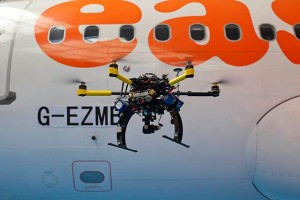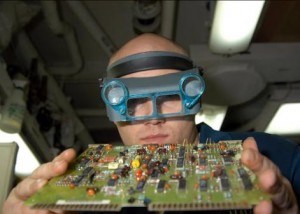Is Aerospace short-sighted about maintenance innovation?
A student from the Technical University of Amsterdam contacted us because he was conducting an investigation into the extent to which large Aerospace companies would engage with small ones, ie SMEs, for their innovations. He interviewed a wide range of aerospace companies including Airbus, Bombardier and Eaton. We were intrigued by his study and keen to see the outcomes.
His headline findings stated that large aerospace organisations had a tendency to be risk averse and therefore were largely inclined to stick with existing suppliers and 'tried and tested' approaches.
"Aircraft manufacturers won’t always search out all capable firms, as development time is short and it is easier - and presumed more cost-effective - to stay with suppliers they already know."
Whilst it was accepted that Aerospace SMEs were a major source of original innovation, it was evident that they tended to struggle in this sector because of lengthy certification/approvals processes; and because of lack of finance to resource the former or to invest adequately in effective sales and marketing. In terms of Quality-Cost-Delivery, SMEs were perceived to offer better Value for Money, but large companies had concerns over smaller companies' viability/stability in delivery and after-sales support.
Perhaps current industry initiatives in the UK are leading the way in mitigating this? The formation of joint Government/industry/academic collaborations under the Aerospace Growth Partnership and the Defence Growth Partnership, with public and industry funding combined, both emphasise the importance of fully integrating SMEs in these activities. Wise words, easy to say, but harder to live up to and sustain.
Innovation focus: new products or maintenance?
Whilst the AGP and DGP pave the way for a bright future in UK manufacturing, for example, their focus appears to be on new products. Human nature means we favour shiny new aircraft over less 'sexy' activities like aircraft maintenance! But the strategy is missing a trick if it doesn't fully engage the aircraft MRO community, because as any support engineer will tell you, the in-service phase of a product's life cycle accounts for at least two-thirds of the whole life cost. That's a huge market sector to overlook. Aircraft MRO and Logistics is vital to the industry's economic output, and so the need for ground-breaking maintenance innovations is greater than ever.
Emerging Maintenance Innovations
In 2013 Copernicus Technology carried out a survey in preparing to present at the Royal Aeronautical Society's Airworthiness & Maintenance conference and the survey showed that there was an even balance between hardware and data/software related innovations. We asked participants:
“In the last 10 to 15 years what have been the top innovations in aerospace maintenance tools, equipment and processes that have made major improvements at the 'hangar-floor' level”
Here's a flavour of what we got back in response:
Processes
- Lean
- Safety
- Human Factors
- Computer Based Training
- Non-Destructive Testing
- Design for Testability
Hardware
- RFID tagging
- Built-In Test
- Prognostics & Health Monitoring
- Intermittent Fault Detection
- Reconfigurable Avionics
Data
- Data Mining/Data Analytics
- Standard Symptom Capture ("Symptom Diagnostics")
Drones and Data

In recent months other innovations started to attract wider attention. The UK low-cost carrier Easyjet announced a range of innovations being developed to improve the efficiency of their Maintenance, Repair & Overhaul (MRO) operations. The most eye-catching announcement featured the proposed use of UAVs for aircraft external inspections, but just as significant - albeit not as sexy! - is their introduction of an early fault prognosis tool that will transmit real-time aircraft system data via the ACARS messaging system. The transmitted data will then be used to troubleshoot known technical faults before the plane lands. Then there is the issue of how to deal with the vast ‘data lakes’ generated by modern aircraft operations and maintenance…
Staying on the theme of exploiting data, RFID tagging continues to grow in significance. In one example, Abu Dhabi Aircraft Technologies (ADAT) have been developing their exploitation of RFID data at Airbus' RFID Centre of Excellence, a site at which the aircraft maker displays, demonstrates and tests RFID systems for its own internal use and to assist its customers in deploying RFID technology. ADAT plans to use the RFID tags throughout the MRO cycle to obtain a real-time view into the progress of each MRO service being provided for every component to identify where delays occurs view the parts allocated to the various repair stations to enable workflow prioritisation.
Overall the need for disruptive and genuinely effective innovations in aerospace MRO is becoming increasingly vital. The recent release of International Air Transport Association's (IATA) 2013 Safety Report states that maintenance “events” (specific operations that were done wrongly, or not done when required) contributed to 10% of the 432 accidents investigated between 2009 and 2013, while 29% involved some kind of aircraft malfunction. The Report also highlights a growing tendency to put “too much effort… into oversight of the documentation trail, rather than the work being physically performed on the aircraft”. Australian research in this area points to problems observed in some "offshore MROs" which would not be picked up by such an approach – for example, using non-approved tools in paint removal, which can damage aircraft skins causing tears in fuselages during flight. The research also examines the implications of continued technician shortages:
"According to the ICAO, world training capacity in 2010 was falling short by some 18,000 places every year of the number required to meet forecast minimum needs in 2030.
The Asia-Pacific region as a whole is projected to train fewer than a quarter of the new aircraft technicians it will need to accommodate the requirements of its own national fleets."
So challenging times ahead. Safety concerns. Shortages of suitably qualified and experienced technician personnel. Cost savings targeting the MRO environment. Innovation is not the only answer to these problems, but it is abundantly clear there can be no let up in pursuing innovation in MRO to sustain safety, improve operational reliability and, of course, reduce costs.

